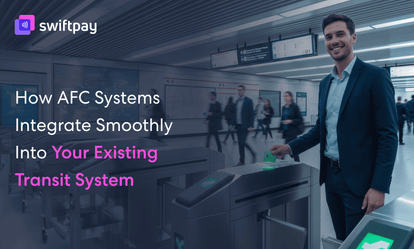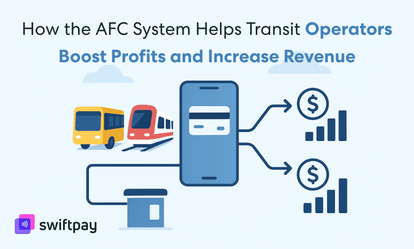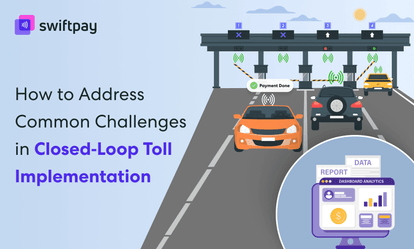Many parking operators obsess over occupancy rates, pricing strategies, and enforcement but overlook a crucial driver of repeat revenue: the payment experience itself.
And when payment becomes the friction point, people don’t come back.
The reality is simple: the easier it is to pay, the more likely customers are to return, and the more reliable your revenue becomes.
That’s why it’s vital for parking operators like you to understand the link between payment experience and revenue.
In this blog, you will learn how the convenience and reliability of your parking payment system directly impact your revenue stream and what parking businesses like yours can do to fix the leaks before they grow.
Let’s begin.
The direct impact of payment experience on revenue
Payment is not just the final step of a parking session. It’s the moment your customers evaluate the ease, efficiency, and professionalism of your business operation—all in a matter of seconds. And those few seconds matter more than you might think.
In parking, there’s limited face-to-face interaction.
There are no servers. No salespeople. No staff members. That means payment becomes the defining touchpoint.
And it can either close the loop with satisfaction or open the door to frustration for your customers.
Think about it: long queues at kiosks, broken ticket machines, or manual payments delay the entry and exits. Plus, they also damage trust in your business.
Besides, delays may lead to:
- Complaints
- Missed appointments
- Traffic bottlenecks
All of that leaves a lasting negative impression. And when customers feel rushed or irritated once, they’re far less likely to return. Because that negative impression is psychological as well. Research shows that, usually, people tend to remember negative experiences more.
But the good news is that smooth and fast payments can turn a forgettable parking session into a pleasant one. That is often the difference between a one-time visitor and a loyal customer.
If you’re still treating payment as a necessary afterthought, it’s time to reconsider. Because, in a way, your revenue depends on it.
How parking payments differ from other businesses
Unlike retail or hospitality, parking payment is a uniquely hands-off experience. Let’s break down why it needs special attention.
Payment often happens without staff involvement
Most parking locations are fully self-service. This means it’s most likely that there will be no one around except maybe a security guard.
So, if your parking payment system isn’t intuitive, your users will be left confused, with no one to ask for help. That means your tech (system) needs to do the talking and help them.
Users are often in a rush or under pressure
People are usually heading to work, appointments, flights, or meetings. So, even the delay of a few minutes at pay stations feels like a major inconvenience when time is tight.
Payments are tied to time, not products
Parking isn’t a ‘purchase’ in the traditional sense; it’s a timed service.
That makes accuracy and transparency quite essential. Any confusion over charges or timing can slowly erode trust and confidence.
Parking environments can be challenging for hardware
Unlike climate-controlled retail spaces, parking lots and spaces expose payment hardware to harsh conditions—heat, cold, dust, rain, and poor lighting—which often impacts reliability and usability.
This is a crucial factor that many parking operators overlook.
Drawbacks of current and traditional parking payment systems
Many parking payment systems are still in use today that simply weren’t built for modern user expectations.
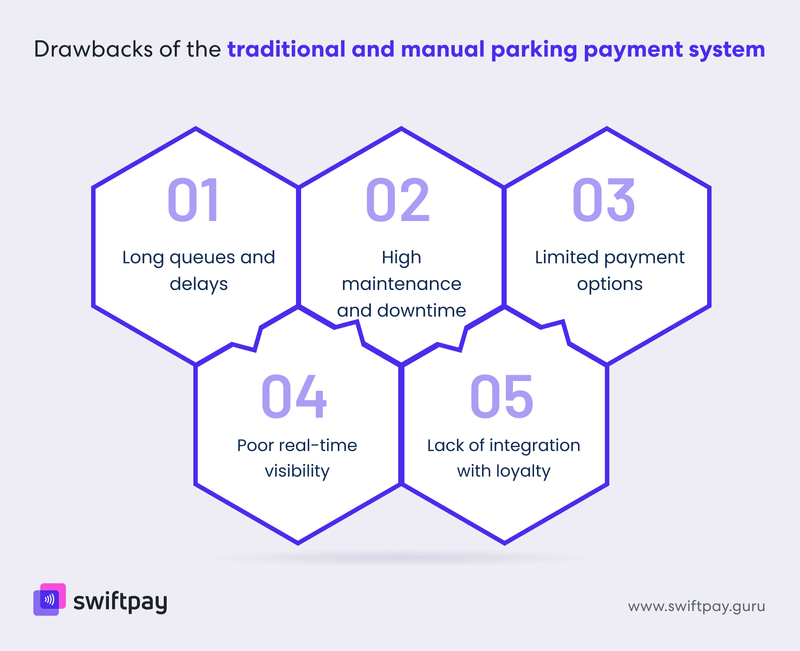
Long queues and delays at pay stations
When just a few kiosks serve a large parking lot, wait times stack up. It’s a frustrating end to a user’s visit and a major source of complaints.
High maintenance and downtime of physical infrastructure
Ticket printers, gate arms, and touchscreens require regular servicing and maintenance. When they go down, it has a direct impact on your revenue and your reputation as well.
Limited payment options
Some systems only accept cash or physical cards. This means it ignores the customers who rely on mobile wallets, QR codes, or contactless payments.
Poor real-time visibility for users
Without clear updates on remaining parking time and fees, users are left guessing. That uncertainty often leads to early exits, which means missed revenue.
Or if users end up overstaying, then they have to pay more than they intended. This is damaging to your business’s image.
Lack of integration with loyalty or validation systems
Traditional systems for parking payments rarely connect with promotions, validations, or rewards, which means operators like you miss the chance to build repeat visits and customer retention.
Read more: What Makes Parking Payment System Truly Convenient for Users
Emerging payment technologies for parking
Thankfully, things are changing. New technologies are streamlining payment while opening the door to better customer experiences and operational control.
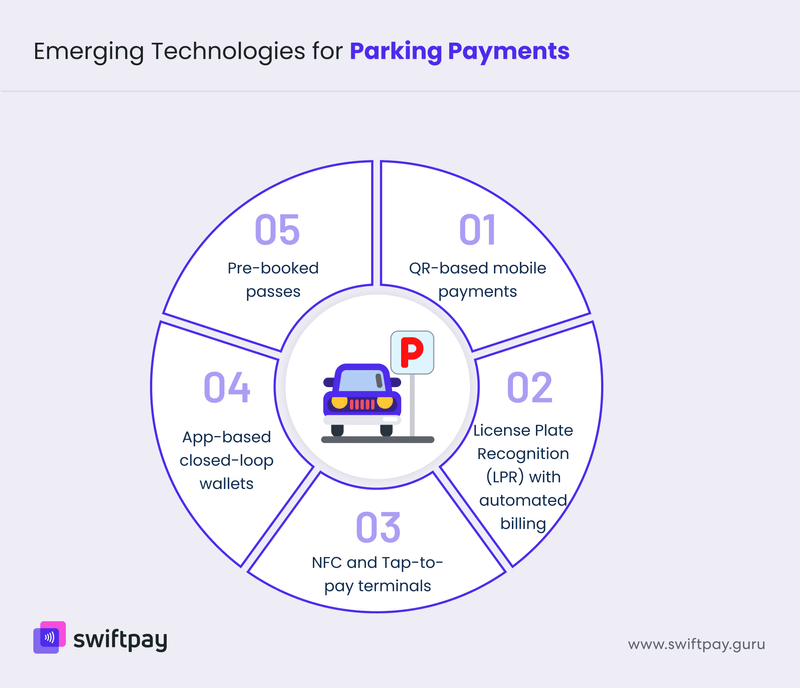
QR-based mobile payments
To make this type of payment, users don’t have to wait at machines. They scan a QR code with their phone, pay in seconds, and drive away.
License Plate Recognition (LPR) with automated billing
This automated parking payment system requires no tickets or barriers. Just seamless entry and exit using license plates—a frictionless experience for everyone.
NFC and Tap-to-pay terminals
Mobile wallets and contactless cards mean faster payments, which is specifically helpful when users are in a hurry. This provides the most seamless payment experience, and it is preferred by most customers these days.
App-based closed-loop wallets
This is like an all-in-one experience. Users park, pay, track receipts, and earn rewards within a branded app, while operators like you maintain full control over data, pricing, and promotions.
Pre-booked passes
This parking payment method allows users to reserve and pay for parking in advance. This helps ensure a spot upon arrival, and it also helps reduce traffic congestion.
Why closed-loop payments are ideal for parking payments
Among the new tech available for parking payments, closed-loop payments stand out as particularly well-suited to parking environments. Here’s why they work so well for operators like you and your customers:
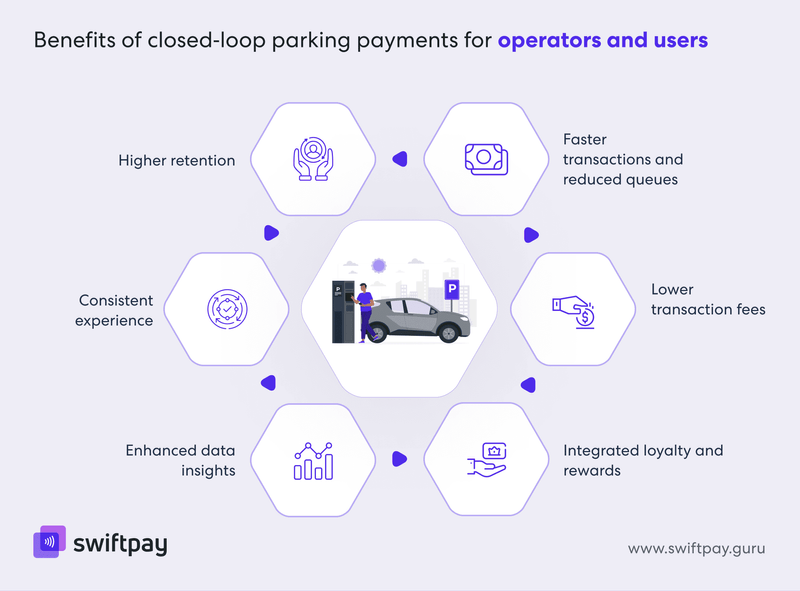
Faster transactions and reduced queues
When users can pay in advance or use contactless payments for parking, lines vanish. That means smoother traffic flow and happier customers.
Lower transaction fees for operators
Because closed-loop systems don’t rely on third-party processors (like Visa, Mastercard, Amex, etc.), you save on interchange fees. Over time, those savings add up.
Integrated loyalty and rewards for users
With closed-loop e-wallet apps, you can offer points, time-based rewards, or discounts to your frequent users—all inside the payment app. That turns one-time parkers into regulars.
Enhanced data for smarter pricing and planning
Closed-loop systems for parking payments let you gather detailed behavior and usage insights. You can use these insights to adjust rates, understand demand, and plan better.
Consistent experience across locations
Whether a customer parks downtown or near the airport, your closed-loop system offers the same familiarity and branded interface. This is quite helpful in building trust and recognition silently and subconsciously.
Higher retention through app ecosystems
When users handle everything—from entry to exit to rewards—inside your branded parking payment app, they’re more likely to return. More often than not, it’s the convenience that keeps them coming back.
Final thoughts
Parking might be a low-touch industry, but the payment experience leaves a high-impact impression.
A cumbersome payment process can undo an otherwise smooth visit. On the other hand, a fast, transparent, and user-friendly payment process boosts satisfaction, encourages repeat visits, and protects your revenue.
New technologies keep emerging. And that means consumer expectations will also keep evolving.
Closed-loop payment solutions are more than just a modern, convenient payment system for parking. These systems are a strategic advantage for your parking business as well.
They reduce costs, improve retention, and give you full control over the experience your customers walk away with.
If you're ready to turn the payment process into a competitive edge, SwiftPay is the best solution for you.
It is built for parking businesses like yours—helping you streamline operations, gain insights, and grow revenue, one seamless transaction at a time.


